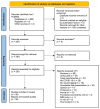Are the Post-COVID-19 Posttraumatic Stress Disorder (PTSD) Symptoms Justified by the Effects of COVID-19 on Brain Structure? A Systematic Review
- PMID: 37511753
- PMCID: PMC10381510
- DOI: 10.3390/jpm13071140
Are the Post-COVID-19 Posttraumatic Stress Disorder (PTSD) Symptoms Justified by the Effects of COVID-19 on Brain Structure? A Systematic Review
Abstract
COVID-19 affects brain function, as deduced by the "brain fog" that is often encountered in COVID-19 patients and some cognitive impairment that is observed in many a patient in the post-COVID-19 period. Approximately one-third of patients, even when they have recovered from the acute somatic disease, continue to show posttraumatic stress disorder (PTSD) symptoms. We hypothesized that the persistent changes induced by COVID-19 on brain structure would overlap with those associated with PTSD. We performed a thorough PubMed search on 25 April 2023 using the following strategy: ((posttraumatic OR PTSD) AND COVID-19 AND (neuroimaging OR voxel OR VBM OR freesurfer OR structural OR ROI OR whole-brain OR hippocamp* OR amygd* OR "deep gray matter" OR "cortical thickness" OR caudate OR striatum OR accumbens OR putamen OR "regions of interest" OR subcortical)) OR (COVID-19 AND brain AND (voxel[ti] OR VBM[ti] OR magnetic[ti] OR resonance[ti] OR imaging[ti] OR neuroimaging[ti] OR neuroimage[ti] OR positron[ti] OR photon*[ti] OR PET[ti] OR SPET[ti] OR SPECT[ti] OR spectroscop*[ti] OR MRS[ti])), which produced 486 records and two additional records from other sources, of which 36 were found to be eligible. Alterations were identified and described and plotted against the ordinary PTSD imaging findings. Common elements were hypometabolism in the insula and caudate nucleus, reduced hippocampal volumes, and subarachnoid hemorrhages, while white matter hyperintensities were widespread in both PTSD and post-COVID-19 brain infection. The comparison partly supported our initial hypothesis. These data may contribute to further investigation of the effects of long COVID on brain structure and function.
Keywords: COVID-19; anterior cingulated cortex; hippocampus; neuroimaging; pandemic; post-traumatic stress disorder.
Conflict of interest statement
The authors declare no conflict of interest.
Figures

References
-
- World Health Organization WHO Director-General’s Opening Remarks at the Media Briefing on COVID-19—11 March 2020. [(accessed on 29 April 2023)]. Available online: https://www.who.int/director-general/speeches/detail/who-director-genera....
-
- Worldometer COVID-19 Coronavirus Pandemic. [(accessed on 29 April 2023)]. Available online: https://www.worldometers.info/coronavirus/
-
- Global Burden of Disease Long COVID Collaborators. Wulf Hanson S., Abbafati C., Aerts J.G., Al-Aly Z., Ashbaugh C., Ballouz T., Blyuss O., Bobkova P., Bonsel G., et al. Estimated global proportions of individuals with persistent fatigue, cognitive, and respiratory symptom clusters following symptomatic COVID-19 in 2020 and 2021. JAMA. 2022;328:1604–1615. doi: 10.1001/jama.2022.18931. - DOI - PMC - PubMed
-
- O’Mahoney L.L., Routen A., Gillies C., Ekezie W., Welford A., Zhang A., Karamchandani U., Simms-Williams N., Cassambai S., Ardavani A., et al. The prevalence and long-term health effects of Long COVID among hospitalised and non-hospitalised populations: A systematic review and meta-analysis. EClinicalMedicine. 2022;55:101762. doi: 10.1016/j.eclinm.2022.101762. Erratum in EClinicalMedicine 2023, 59, 101959. - DOI - PMC - PubMed
Publication types
LinkOut - more resources
Full Text Sources
Miscellaneous

